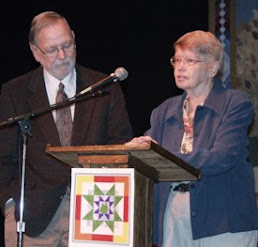 |
| The center bee does the waggle dance. (Photo by Heather Broccard-Bell, CC BY-ND) |
They've got a waggle dancer, waggle dance groupies and distance dialects. It's not a rural string band, Black Velvet line dancing, or even "Hey! . . .Ho!" by the Lumineers. It's how honeybees tell each other "where to find resources such as food, water or nest sites,"
reports James C. Nieh for
The Conversation, a platform for journalism by academics. Nieh studied how many "waggle skills" bees are born with and how many they learn from older bees, and reports, "In addition, each colony has a 'dance floor,' or the space where bees dance, with
complex terrain that the dancers may learn to better navigate over time or by following in the footsteps of older dancers."
The connection between humans and whales has been so strong that a humpback whale song was included on
NASA's Golden Records, launched into space on the Voyager spacecrafts as a representation of life on earth,
reports Kiley Bense of
Inside Climate News. "After decades of conservation efforts to protect whales, two recent books shed light on why they're still threatened—and how we might change that. . . . Tom Mustill's book,
How to Speak Whale, offers one possible means of altering whales' fate: technology."
 |
Black-capped chickadee (Photo by Scott Martin, Cornell Lab)
|
That's for the birds! What? Bugs. In California, the
Wild Farm Alliance is working to bring birds back to the farm as natural pest control,
reports Twilight Greenaway of
Civil Eats. WFA Executive director Jo Ann Baumgartner told Greenaway, "There are so many beneficial things that birds do related to pest control, and different kinds of birds offer different kinds of pest control." Who are the best insectivorous birds? "Tree swallows, which are aerial foragers, meaning they're cruising around in the air and catching moths, flies, and flying insects," Greenaway shares. "There's chickadees, titmice, ash-throated flycatchers, violet-green swallows, and various kinds of wrens and nuthatches."
Mention Canada, and many people will think of mountains, beauty, Mounties, etc. One thing people don't think about is tornadoes. Canada has the second-highest number of tornadoes each year,
reports Oliver Whang for
The New York Times. Another surprise, Canada's tornadoes are hard to count. "Canada is vast. . . . Canadian tornadoes end up touching down in areas with no [human] witnesses. . . . The Northern Tornadoes Project in London, Ontario, has been seeking to address this. . . . Using social media and eyewitness reports, satellite imagery, drone footage and fallen trees, the group has tracked more Canadian tornadoes than ever before."
 |
Left: Black widow spider. Right: Brown widow spider.
(Photos by Louis Coticchio, The New York Times)
|
Deadly, feared, found in song lyrics and old sneakers, black widow spiders have fearsome reputations. "But throughout the South, the bulbous arachnids with red hourglasses on their bellies are engaged in a lethal competition with the brown widow, a relative from abroad — and they're losing,"
reports Asher Albein of
The New York Times. "Brown widows tend to be bold, investigating nearby webs and attacking spiders that don't resist. . . . The shy, retiring black widows generally try to escape, fighting back only as a last resort."
Found an egg in your pocket? Well, that's worth quite a bit. "For the first time in human history, the care and keeping of 11 hens all winter to receive one egg a day is now a pretty good deal,"
reports Eliza Blue of
The Daily Yonder. "Imagine my delight then when the very next morning I arrived at the coop to discover not one, not two, but
four eggs! It felt like I had won the egg lottery now that I knew how much they were worth. I complimented every single one of the hens since I couldn't be sure who had actually laid the eggs. . . . It also was a wonderful reminder that we've tipped toward spring and spring's abundance as hens increase their laying with the return of the light."
In some states, insects are not considered wildlife. They are left unprotected, and yet . . . "Bees, butterflies and beetles pollinate plants, enrich soils and provide a critical protein source for species up the food chain. The
U.S. Forest Service says, 'Without pollinators, the human race and all of earth's terrestrial ecosystems would not survive,'"
reports Catrin Einhorm of
The New York Times. "Conservation officials in at least 12 states have their hands tied, legally speaking, when it comes to protecting insects. The creatures are simply left out of state conservation statutes, or their situation is ambiguous."
























